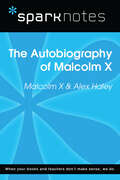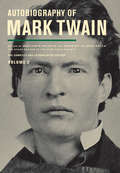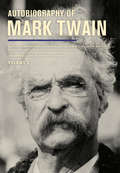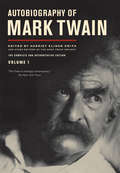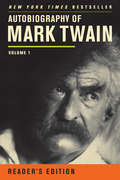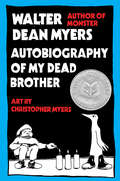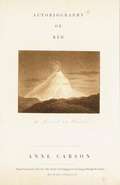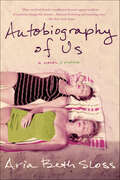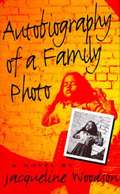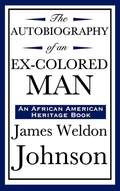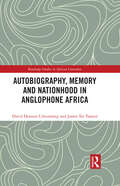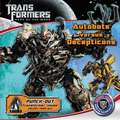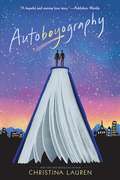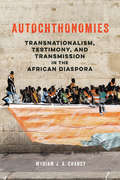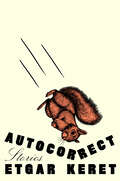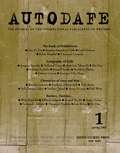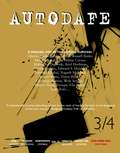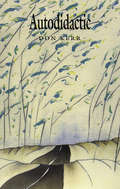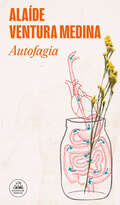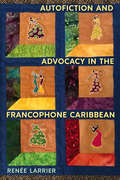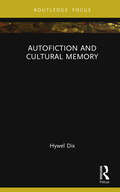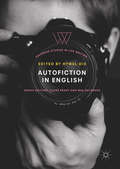- Table View
- List View
Autobiography of Malcolm X (SparkNotes Literature Guide Series)
by SparkNotesAutobiography of Malcolm X (SparkNotes Literature Guide) by Malcolm X and Alex Haley Making the reading experience fun! Created by Harvard students for students everywhere, SparkNotes is a new breed of study guide: smarter, better, faster.Geared to what today's students need to know, SparkNotes provides:chapter-by-chapter analysis explanations of key themes, motifs, and symbols a review quiz and essay topicsLively and accessible, these guides are perfect for late-night studying and writing papers.
Autobiography of Mark Twain, Volume 2
by Mark Twain Victor Fischer Benjamin Griffin Michael Barry Frank Ms Harriet E. SmithMark Twain's complete, uncensored Autobiography was an instant bestseller when the first volume was published in 2010, on the centennial of the author's death, as he requested. Published to rave reviews, the Autobiography was hailed as the capstone of Twain's career. It captures his authentic and unsuppressed voice, speaking clearly from the grave and brimming with humor, ideas, and opinions. The eagerly-awaited Volume 2 delves deeper into Mark Twain's life, uncovering the many roles he played in his private and public worlds. Filled with his characteristic blend of humor and ire, the narrative ranges effortlessly across the contemporary scene. He shares his views on writing and speaking, his preoccupation with money, and his contempt for the politics and politicians of his day. Affectionate and scathing by turns, his intractable curiosity and candor are everywhere on view. Editors: Benjamin Griffin and Harriet E. Smith Associate Editors: Victor Fischer, Michael B. Frank, Sharon K. Goetz and Leslie Diane Myrick
Autobiography of Mark Twain, Volume 3
by Mark Twain Benjamin Griffin Ms Harriet E. SmithThe surprising final chapter of a great American life. When the first volume of Mark Twain's uncensored Autobiography was published in 2010, it was hailed as an essential addition to the shelf of his works and a crucial document for our understanding of the great humorist's life and times. This third and final volume crowns and completes his life's work. Like its companion volumes, it chronicles Twain's inner and outer life through a series of daily dictations that go wherever his fancy leads. Created from March 1907 to December 1909, these dictations present Mark Twain at the end of his life: receiving an honorary degree from Oxford University; railing against Theodore Roosevelt; founding numerous clubs; incredulous at an exhibition of the Holy Grail; credulous about the authorship of Shakespeare's plays; relaxing in Bermuda; observing (and investing in) new technologies. The Autobiography's "Closing Words" movingly commemorate his daughter Jean, who died on Christmas Eve 1909. Also included in this volume is the previously unpublished "Ashcroft-Lyon Manuscript," Mark Twain's caustic indictment of his "putrescent pair" of secretaries and the havoc that erupted in his house during their residency. Fitfully published in fragments at intervals throughout the twentieth century, Autobiography of Mark Twain has now been critically reconstructed and made available as it was intended to be read. Fully annotated by the editors of the Mark Twain Project, the complete Autobiography emerges as a landmark publication in American literature. Editors: Benjamin Griffin and Harriet Elinor Smith Associate Editors: Victor Fischer, Michael B. Frank, Amanda Gagel, Sharon K. Goetz, Leslie Diane Myrick, Christopher M. Ohge
Autobiography of Mark Twain: The Complete and Authoritative Edition, Vol. 1
by Mark Twain Michael B. Frank Victor Fischer Harriet E. Smith Benjamin Griffin"I've struck it!" Mark Twain wrote in a 1904 letter to a friend. "And I will give it away--to you. You will never know how much enjoyment you have lost until you get to dictating your autobiography." Thus, after dozens of false starts and hundreds of pages, Twain embarked on his "Final (and Right) Plan" for telling the story of his life. His innovative notion--to "talk only about the thing which interests you for the moment"--meant that his thoughts could range freely. The strict instruction that these texts remain unpublished for 100 years meant that when they came out, he would be "dead, and unaware, and indifferent," and that he was therefore free to speak his "whole frank mind." The year 2010 marks the 100th anniversary of Twain's death. In celebration of this important milestone and in honor of the cherished tradition of publishing Mark Twain's works, UC Press is proud to offer for the first time Mark Twain's uncensored autobiography in its entirety and exactly as he left it. This major literary event brings to readers, admirers, and scholars the first of three essential volumes and presents Mark Twain's authentic and unsuppressed voice, brimming with humor, ideas, and opinions, and speaking clearly from the grave as he intended.
Autobiography of Mark Twain: Volume 1, Reader's Edition
by Mark Twain Harriet E. SmithThe year 2010 marked the 100th anniversary of Mark Twain's death. In celebration of this important milestone and in honor of the cherished tradition of publishing Mark Twain's works, UC Press published Autobiography of Mark Twain, Volume 1, the first of a projected three-volume edition of the complete, uncensored autobiography. The book became an immediate bestseller and was hailed as the capstone of the life's work of America's favorite author. This Reader's Edition, a portable paperback in larger type, republishes the text of the hardcover Autobiography in a form that is convenient for the general reader, without the editorial explanatory notes. It includes a brief introduction describing the evolution of Mark Twain's ideas about writing his autobiography, as well as a chronology of his life, brief family biographies, and an excerpt from the forthcoming Autobiography of Mark Twain, Volume 2--a controversial but characteristically humorous attack on Christian doctrine.
Autobiography of My Dead Brother
by Walter Dean Myers Christopher MyersThe thing was that me and Rise were blood brothers, but sometimes I really didn't know him. . . . <P><P> As Jesse fills his sketchbook with drawings and portraits of Rise, he tries to make sense of the complexities of friendship, loyalty, and loss in a neighborhood plagued by drive-bys, vicious gangs, and abusive cops.
Autobiography of Red: A Novel in Verse
by Anne CarsonPoet Anne Carson reinvents a genre in Autobiography of Red, a stunning work that is both a novel and a poem, both an unconventional re-creation of an ancient Greek myth and a wholly original coming-of-age story set in the present.
Autobiography of Us: A Novel
by Aria Beth SlossA gripping debut novel about friendship, loss and love; a confession of what passed between two women who met as girls in 1960s Pasadena, CaliforniaComing of age in the patrician neighborhood of Pasadena, California during the 1960s, Rebecca Madden and her beautiful, reckless friend Alex dream of lives beyond their mothers' narrow expectations. Their struggle to define themselves against the backdrop of an American cultural revolution unites them early on, until one sweltering evening the summer before their last year of college, when a single act of betrayal changes everything. Decades later, Rebecca's haunting meditation on the past reveals the truth about that night, the years that followed, and the friendship that shaped her.Autobiography of Us by Aria Beth Sloss is an achingly beautiful portrait of a decades-long bond. A rare and powerful glimpse into the lives of two women caught between repression and revolution, it casts new light on the sacrifices, struggles, victories and defeats of a generation.
Autobiography of a Corpse
by Adam Thirlwell Sigizmund Krzhizhanovsky Joanne TurnbullAn NYRB Classics OriginalThe stakes are wildly high in Sigizmund Krzhizhanovsky's fantastic and blackly comic philosophical fables, which abound in nested narratives and wild paradoxes. This new collection of eleven mind-bending and spellbinding tales includes some of Krzhizhanovsky's most dazzling conceits: a provincial journalist who moves to Moscow finds his existence consumed by the autobiography of his room's previous occupant; the fingers of a celebrated pianist's right hand run away to spend a night alone on the city streets; a man's lifelong quest to bite his own elbow inspires both a hugely popular circus act and a new refutation of Kant. Ordinary reality cracks open before our eyes in the pages of Autobiography of a Corpse, and the extraordinary spills out.g in nested narratives, wild paradox, and improbably high stakes--what would you do if a Stygian toad landed on your pillow one night and asked for help in saving the world by building a bridge to death?--the unlikely stories in Autobiography of a Corpse ask you to take a second look at the cracks in everyday reality.
Autobiography of a Family Photo
by Jacqueline Woodson"It is the Vietnam era, the "Brady Bunch" era, a time when men walk on the moon and families unravel. Brooklyn pulses with African American and Latino life, a world separated by invisible barriers from the white world. Through the eyes and ears of the unnamed narrator, we come to know - in all its sensuality and brutality - a world that is held together by a young girl's fragile perceptions and cautiously emerging desires. Autobiography of a Family Photo is a coming-to-consciousness, coming-of-age story of a young girl, told with passion and poetry, honesty and clear vision." --BOOK JACKET. Title Summary field provided by Blackwell North America, Inc. All Rights Reserved
Autobiography of an Ex-Colored Man
by James Weldon JohnsonJames Weldon Johnson's landmark novel is an emotionally gripping and poignant look into race relations. The protagonist, a half-white, half-black man of very light complexion, known only as an ex-colored man, makes a choice between his heritage, and the art that he loves and the ability to escape the inherent racism that he faces, by passing as a white. Because of his knowledge of both cultures he is able to give us startling revelations into both cultures.
Autobiography, Memory and Nationhood in Anglophone Africa (Routledge Studies in African Literature)
by David Ekanem Udoinwang James Tar TsaaiorThis book provides an important critical analysis of the autobiographies of nine major leaders of national liberation movements in Africa. By examining their self-narratives, we can better understand how decolonisation unfolded and how activist-politicians sought to immortalise their roles for posterity. Focusing on the autobiographies of Peter Abrahams, Albert Luthuli, Ruth First and Nelson Mandela (South Africa), Nnamdi Azikiwe (Nigeria), Kenneth Kaunda (Zambia), George Mwase (Malawi), Kwame Nkrumah (Ghana), Maurice Nyagumbo (Zimbabwe), and Oginga Odinga (Kenya), the book uncovers the social and cultural forces which galvanized the anti-colonial resistance movement in African societies. In particular, the book explores the disdain for foreign domination, economic exploitation and cultural imperialism. It delves into themes of African cultural sovereignty before the colonial encounter, the disruptive presence of colonialism, the nationalist ferment against European imperial domination, the achievement of political autonomy by African nation-states and the corpus of contradictions which attended postcolonial becoming. With important insights on how these key historical figures navigated the process of self-determining nationhood in Africa, this book will be of interest to researchers of African literature, history, and politics.
Autobots Versus Decepticons (Transformers)
by Katharine TurnerAutobots and Decepticons face off in this fun storybook based on Transformers: Dark of The Moon. Decepticons unleash hordes of evil robots on Earth and it's up to Optimus Prime and the Transformers to save it!
Autoboyography
by Christina Lauren<p>Fangirl meets Simon vs. the Homo Sapiens Agenda in this “sensitive and complex” (BCCB) coming-of-age novel from New York Times bestselling author Christina Lauren about two boys who fall in love in a writing class—one from a progressive family and the other from a conservative religious community. <p>Three years ago, Tanner Scott’s family relocated from California to Utah, a move that nudged the bisexual teen temporarily back into the closet. Now, with one semester of high school to go, and no obstacles between him and out-of-state college freedom, Tanner plans to coast through his remaining classes and clear out of Utah. <p>But when his best friend Autumn dares him to take Provo High’s prestigious Seminar—where honor roll students diligently toil to draft a book in a semester—Tanner can’t resist going against his better judgment and having a go, if only to prove to Autumn how silly the whole thing is. Writing a book in four months sounds simple. Four months is an eternity. <p>It turns out, Tanner is only partly right: four months is a long time. After all, it takes only one second for him to notice Sebastian Brother, the Mormon prodigy who sold his own Seminar novel the year before and who now mentors the class. And it takes less than a month for Tanner to fall completely in love with him.</p>
Autochthonomies: Transnationalism, Testimony, and Transmission in the African Diaspora (New Black Studies Series)
by Myriam ChancyIn Autochthonomies, Myriam J. A. Chancy engages readers in an interpretive journey. She lays out a radical new process that invites readers to see creations by artists of African descent as legible within the context of African diasporic historical and cultural debates. By invoking a transnational African/diasporic lens and negotiating it through a lakou or ”yard space,” we can see such identities transfigured, recognized, and exchanged. Chancy demonstrates how the process can examine the salient features of texts and art that underscore African/diasporic sensibilities and render them legible. What emerges is a potential for richer readings of African diasporic works that also ruptures the Manichean binary dynamics that have dominated previous interpretations of the material. The result: an enriching interpretive mode focused on the transnational connections between subjects of African descent as the central pole for reader investigation. A bold challenge to established scholarship, Autochthonomies ranges from Africa to Europe and the Americas to provide powerful new tools for charting the transnational interactions between African cultural producers and sites.
Autocorrect: Stories
by Etgar KeretFrom one of the most acclaimed masters of the short story form whom the New York Times calls &“Genius,&” a darkly funny collection of stories explores themes of identity, reality, and meaning.Etgar Keret is the world&’s most famous living Israeli writer, known for writing short stories that are lean and accessible in style, and whimsical, surrealist, and darkly funny in subject. His work explores life&’s smallest, most unremarkable interactions in ways that are profound and unusual. The characters populating his fiction have relatable work and relationship problems. They live in a world of ever-advancing technology, but it is always degraded by the baseness of human passions and brutality: a character&’s partner is a reality show contestant from a parallel dimension; another finds the asteroid they paid to have named after their wife is scheduled to collide with earth; and an elderly widow convinces a popular AI program to commit suicide.These stories speak to our current moment in time: the uncertainty and fragility—full of misunderstandings and miscommunications—while looking for reasons and the strength to find hope. His stories reveal the fault lines and uncomfortable truths in our society in a style that is memorably his own.
Autodafe 1: The Journal of the International Parliament of Writers
by International Parliament of WritersAUTODAFE is a collection of reports, interviews, correspondence, narratives, and stories from around the world. The review aims to be a place for debate and experimentation, a place where writers, silenced by censorship join voices with world-renowned writers. The contributors are all members of the International Parliament of Writers; the pieces are original to Autodafe. The journal's common themes are the reflection of social and political realities of the world, censorship, the interdict of language, and the effects of globablization among others.
Autodafe 3/4: The Journal of the International Parliament of Writers
by International Parliament of WritersAUTODAFE is a collection of reports, interviews, correspondence, narratives, and stories from around the world. The review aims to be a place for debate and experimentation, a place where writers, silenced by censorship join voices with world-renowned writers. The contributors are all members of the International Parliament of Writers; the pieces are original to Autodafe. The journal's common themes are the reflection of social and political realities of the world, censorship, the interdict of language, and the effects of globablization among others.
Autodidactic
by Don KerrShortlisted for the 1998 Saskatchewan Book Award for Poetry Don Kerr's fifth poetry collection is a verbal joyride, an exuberant celebration of a book: a celebration of mountains and plains, of growing up and of being young, of being alive in the present moment and absorbing the feel of the road through the palms of your hands on the wheel. Autodidactic represents an erotics of the everyday, a tribute to place (and movement) and to family (and friends). This is not to say that Kerr sentimentalizes the ordinary, but rather that by examining it in the bright prairie sunlight, he is able to reveal its true extraordinariness. The deep-felt humour that is in many of the poems here does not arise from gilding events with comedy, but from the poet's seeing and drawing out of events what is truly and inherently comic within them. In this book Kerr is able to demonstrate the many shades of his voice and the many facets of his craft.
Autofagia
by Alaíde Ventura MedinaUna joven llega a su casa y descubre que su pareja se ha ido. Decide esperarla, obedeciendo el mandase mandato que la relación misma ha impuesto: beber mucha agua y no comer. Conforme las horas avanzan, el silencio comienza a llenarse de voces: las del mundo y las de su cabeza, voces de su madre y de su abuela, que le hablan de su infancia en un pueblo cañero a la orilla del río Autofagia es una novela coral que nos acerca a un mundo de ausencias, a un presente nebuloso que parece devorarse a sí mismo. Es la tercera novela de Alaíde Ventura Medina, una de las narradoras más interesantes de la lengua hispana. «¡Qué librazo ha escrito Alaíde Ventura Medina! Tal como su protagonista, Autofagia es frágil, silenciosa e implacable. En una ciudad hostil, dos chicas definen comer como “el acto de desaparecer la comida”. La falta de alimento les produce debilidad, aturdimiento, sudoración, mareos, pero también complicidad, placer, delirio. Les saca las historias más íntimas de sus órganos y las más fieras del entorno que las ciñe. Entramos en el cuerpo y el territorio con ánimo de cuestionarlo todo.» -Cristina Rivera Garza«El vacío adopta formas caprichosas, fragmenta la realidad y borronea los contornos de los cuerpos. Alaíde Ventura Medina nos domestica las palabras, las retuerce y las siembra en una historia honda que devela sus pliegues con sosiego y enorme belleza. Nos ofrece una extraordinaria novela. a modo de plegaria con presencias que, de tan huecas, colman».-Bibiana Camacho «En Autofagia asistimos al temor y deseo de un cuerpo vulnerable que intenta escude escudriñar presente y pasado. La protagonista parece de una especie distinta, su alma se nutre de lo que sobra, su vida sigue el tiempo del intestino. Alaíde VenturaMedina ha escrito una novela impecable sobre la precarización del cuerpo, los lazos familiares y la resiliencia de las mujeres». -Sylvia Aguilar Zéleny «El rasgo más descollante en la escritura de Alaíde Ventura es su elegancia. Parece nutrirse de géneros laterales o hastainformales como el ensayo personal, el diario íntimo les o el estado de Facebook, pero las historias que genera a partir de esa materia estética son entrañables y profundas, llenas de imágenes conmovedoras a fuer de minimalistas, genes y aparecen vertidas a prosa con una dicción exacta, de inmediatez poderosa. En Autofagiagia, Alaíde logra hacer un retrato de México, desde la intimidad de una tremenda historia de amor. Su agudo estudio de los personajes hace que el dolor se vuelva luminoso». -Julián Herbert
Autofiction and Advocacy in the Francophone Caribbean
by Renée Larrier"Very refreshing in the understanding of Caribbean literature . . . Succeeds in blending close readings of specific texts with a constant awareness of the larger picture. . . . From a theoretical complexity that calls on Glissant, Fanon, Ngugi, Benito-Rojo among others, this profoundly human exploration of autofiction and advocacy in Francophone Caribbean literature study does not succumb to the temptation of theory; that is, she does not demand texts illustrate a rigid theoretical frame; the reverse is true throughout the study."—Cilas Kemedjio, University of RochesterLarrier breaks new ground in analyzing first-person narratives by five Francophone Caribbean writers—Joseph Zobel, Patrick Chamoiseau, Gisele Pineau, Edwidge Danticat, and Maryse Conde—that manifest distinctive interaction among narrators, protagonists, characters, and readers through a layering of voices, languages, time, sources, and identities. Employing the Martinican combat dance—danmye—as a trope, the author argues that these narratives can be read as testimony to the legacy of slavery, colonialism, and patriarchy that denied Caribbean people their subjectivity. In chapters devoted to Zobel, Chamoiseau, Pineau, Danticat, and Conde—who come from Martinique, Guadeloupe, and Haiti—Larrier probes the presence, construction, and strategy of the first-person narrator, which sometimes shifts within the text itself. Providing a perspective different from European travel literature, these texts deliberately position the "I" as a witness and/or performer who articulates experiences ignored or misinterpreted by sojourners' more widely circulated chronicles. While not purporting to speak for others, the "I" is concerned with transmitting what he or she saw, heard, experienced, or endured, therefore disrupting conventional representations of the Francophone Caribbean. Moreover, in modeling authenticity and agency, autofiction is also a form of advocacy.
Autofiction and Cultural Memory (New Literary Theory)
by Hywel DixAutofiction and Cultural Memory breaks new ground in autofiction research by showing how it gives postcolonial writers a means of bearing witness to past cultural or political struggles, and hence of contributing to new forms of cultural memory. Most discussion of autofiction has treated it as an individualistic form, dealing with the personal growth of its authors. In doing so, it privileges narratives of private development over those of social commitment and accords with Western concepts of ownership and authorship. By contrast, Hywel Dix shows how a variety of writers outside the Western world have used the techniques of autofiction in a different way, placing themselves on the side lines of their own stories to show solidarity with struggles against imperialism and tyranny. Drawing on examples from Algeria, Ethiopia, the Caribbean, the Americas, India and Turkey, Dix presents autofiction as a form which combines the life stories of authors with the collective struggles of their societies to restore to view historical injustices that have been marginalised and forgotten. By contributing to new forms of cultural memory, autofiction raises important questions about what we choose to remember and what we value in the present. This book will be of interest to anyone working in postcolonial studies, world literature, trauma studies, autobiography, life writing or social justice.
Autofiction in English (Palgrave Studies in Life Writing)
by Hywel DixThis innovative volume establishes autofiction as a new and dynamic area of theoretical research in English. Since the term was coined by Serge Doubrovsky, autofiction has become established as a recognizable genre within the French literary pantheon. Yet unlike other areas of French theory, English-language discussion of autofiction has been relatively limited - until now. Starting out by exploring the characteristic features and definitions of autofiction from a conceptual standpoint, the collection identifies a number of cultural, historical and theoretical contexts in which the emergence of autofiction in English can be understood. In the process, it identifies what is new and distinctive about Anglophone forms of autofiction when compared to its French equivalents. These include a preoccupation with the conditions of authorship; writing after trauma; and a heightened degree of authorial self-reflexivity beyond that typically associated with postmodernism. By concluding that there is such a field as autofiction in English, it provides for the first time detailed analysis of the major works in that field and a concise historical overview of its emergence. It thus opens up new avenues in life writing and authorship research.
